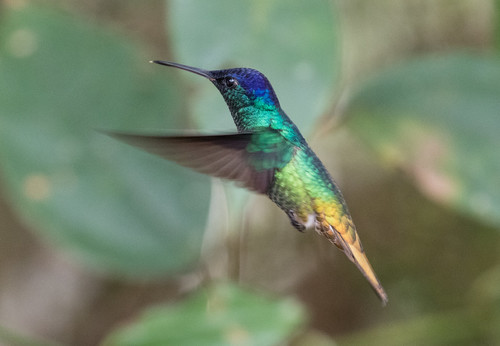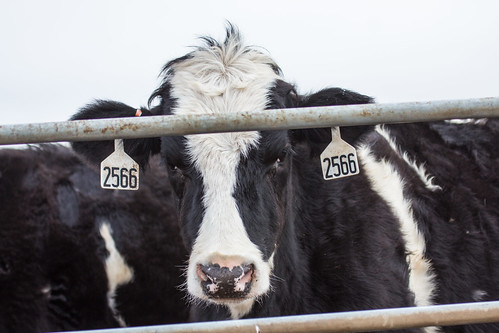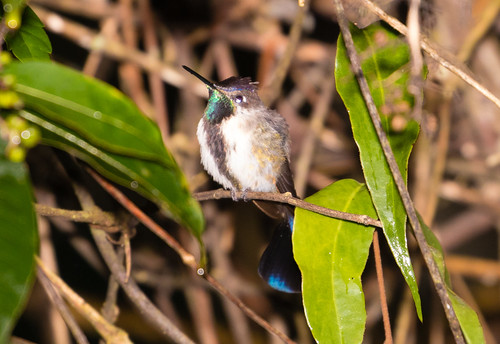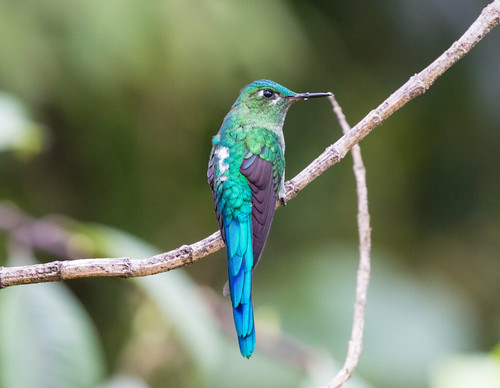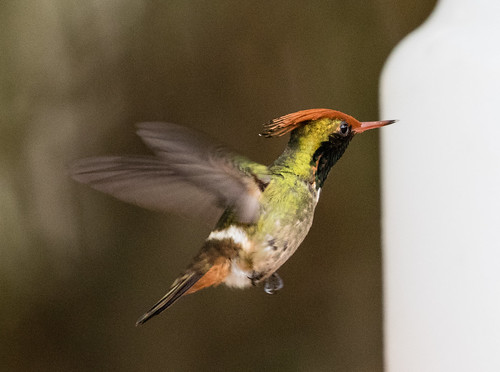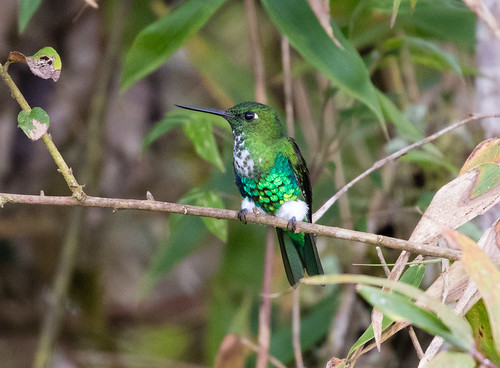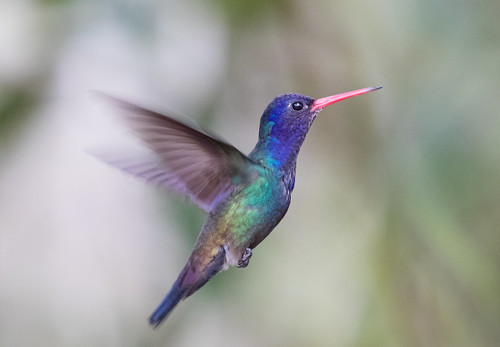
Every year, two million people from around the world head to Peru specifically to visit Machu Picchu. Some of them want to see South American wildlife and enjoy a wonderful experience at one of the genuine wonders of the world, but their visits don’t require protection of anything outside of this area. Indeed, the sheer magnitude of them has caused a lot of development of the area.
Meanwhile, every year barely three thousand people from
around the world head to Peru specifically to see its amazing wildlife. This
surprises me because Peru, a little smaller than Alaska and not quite twice the
size of Texas, is home to such astonishingly magnificent biodiversity. At
current count, 1,824 bird species are found in Peru, almost double the number seen in all of North America north of the Mexican border! And some of those birds of Peru are wondrously amazing, including the
national bird—the Andean Cock-of-the-rock—and the mind-boggling array of 123
different species of hummingbirds, including the Fiery Topaz and the Marvelous
Spatuletail. I was shocked to learn that the number of people
visiting Peru to see an archeological site is three orders of magnitude larger than the number who visit Peru to see its amazing
biological wealth.
Many people concerned about climate change of course see the relatively small number of birders visiting Peru as a good thing: airplane travel accounts for about 4–9 percent of the
total climate change impact of human activity. For them, the fewer people
flying to Peru, or any other place, the better.
It’s absolutely true that climate change is the hugest issue
facing humans right now, and the birds that we treasure as well. The trick is
that as serious as airplane travel is in the overall picture, tropical
deforestation is at least equally critical, contributing at least 10 percent of
the total climate change impact. And agricultural byproducts, especially from
beef production, contribute over 12 percent, exacerbating the effects of deforestation wherever forests are replaced with cattle farms.
We talk about how horrible deforestation and large-scale cattle
production are in the abstract without coming up with specific alternatives.
People struggling to get by and just feed their families in impoverished
counties often have no alternative but to lease or sell their land for logging and then for large-scale cattle or sun-grown coffee production until the soil
is depleted. And the soils of tropical rainforests and cloud forests are
singularly devoid of nutrients, which are locked up in the vegetation. When
the forest is cut, the loss of vegetative-driven humidity in combination with
the low-nutrient soils make regeneration slow—it can take centuries to replace
a cut cloud forest, and many scores of years for even sparse ground cover to
take over.
Meanwhile, local climate change effects due to the loss of the carbon-sucking, humidity-enhancing forest are exacerbated by patches of bare ground. Loss of relatively small amounts of rain or cloud forest leads to bigger losses in rainfall and cloud cover over a more widespread area, leading to more plant and wildlife deaths in a horrifying spiral. Many people don’t realize that the overall rainfall and cloud cover patterns in tropical forests are not mostly due to typical weather systems but are a self-generating set of local conditions because of the forest vegetation itself. When a tropical forest is cut down, climate change is exacerbated by more than the loss of carbon-sucking vegetation.
Meanwhile, local climate change effects due to the loss of the carbon-sucking, humidity-enhancing forest are exacerbated by patches of bare ground. Loss of relatively small amounts of rain or cloud forest leads to bigger losses in rainfall and cloud cover over a more widespread area, leading to more plant and wildlife deaths in a horrifying spiral. Many people don’t realize that the overall rainfall and cloud cover patterns in tropical forests are not mostly due to typical weather systems but are a self-generating set of local conditions because of the forest vegetation itself. When a tropical forest is cut down, climate change is exacerbated by more than the loss of carbon-sucking vegetation.
Right now, poor people in the Peruvian countryside make what little
money they can by logging and agriculture. Some wise, forward-thinking
Peruvians have worked tirelessly to try to persuade them to feed their families
with money earned from hummingbird feeding stations and other ecotourism
ventures that protect rather than cut down the forests.
Some environmentalists think it’s mere selfishness for
birders to want to conserve species for their own sakes in the face of the
massive destruction climate change promises, but protecting cloud and rain
forests is an essential component in the fight against climate change. And the
only way to do that is to give the landowners alternative ways of making a
living without logging. Some kinds of ecotourism really do that.
Several landowners in northern Peru have started promoting
conservation just in the past couple of years, since they discovered that they
can get more money, now and into the future, by letting birders see rare
hummingbirds on their property than they can earn by logging their land. Now
they take pride in getting more and more hummingbirds at their feeding
stations,. Their hummingbird numbers are directly related to the quality of diversity in nearby forested land as well as their own property. So they are not only protecting their own land but also encouraging
their neighbors to preserve their land, too—a win for birds and biodiversity, a win for birders, a win in
the fight against climate change, and a win for the planet.
The government-sponsored fam tour I was on this month was
led by the co-founder of a fantastic small Peruvian company called GreenTours—their mission is embodied in their true commitment to their social and environmental
responsibilities. They compensate for their own CO2 footprint via a
conservation project of the Tambopata National Reserve, and are certified by
the Green Initiative to be a carbon neutral company. The lodges and hotels
where we stayed on our trip had much softer impacts on the environment than the huge
5-star resorts near Machu Picchu. Genuine eco-tourism is an entirely different
thing than tourism in general.
Ecotourism specifically by birders supports the people who
are directly preserving quality cloud and rainforest habitat, which has an even
greater impact in the climate change equation than air travel does. So visiting
Peru to see its birds, even for purely selfish reasons, may be much more
important for fighting climate change than sitting home.
Of course, those of us who understand some of the complexities know that even with respect to deforestation, travel is still a huge driver of climate change. To compensate for my own trip to Peru, I made a contribution to the Rainforest Trust, to ensure that the fuel burned by the airplanes and other vehicles transporting me around would be offset by reforestation to absorb that much carbon. The World Land Trust is another good organization to support for carbon offsets. But I feel good that the individuals who are protecting their land so that I and other birders can see those Marvelous Spatuletails and Emerald-bellied Pufflegs, Sparkling Violetears and Sword-billed Hummingbirds, have prospects of earning an income long into the future not by cutting down their forests, but by protecting them.
Of course, those of us who understand some of the complexities know that even with respect to deforestation, travel is still a huge driver of climate change. To compensate for my own trip to Peru, I made a contribution to the Rainforest Trust, to ensure that the fuel burned by the airplanes and other vehicles transporting me around would be offset by reforestation to absorb that much carbon. The World Land Trust is another good organization to support for carbon offsets. But I feel good that the individuals who are protecting their land so that I and other birders can see those Marvelous Spatuletails and Emerald-bellied Pufflegs, Sparkling Violetears and Sword-billed Hummingbirds, have prospects of earning an income long into the future not by cutting down their forests, but by protecting them.

